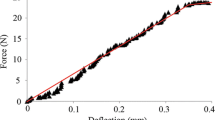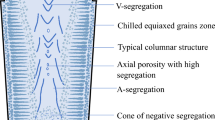Abstract
Several models predicting microshrinkage in castings are revised in this analysis. A mathematical model, based on Niyama criterion, is introduced here which considers the stochastic behavior of pore nucleation during casting solidification. For this model, literature validation is provided for an A356 alloy plate casting. Further validation is provided for a bar geometry cast in a silica sand mold. The model predictions match reasonably well with the experimental pore percentage profile.
Similar content being viewed by others
References
Lee, P.D., Hunt, J.D., “Hydrogen Porosity in Directionally Solidified Aluminum-Copper Alloys: A Mathematical Model,” Acta Mater., vol. 49, pp. 1383–1398 (2001).
Catalina A., Monroe, C., “Simplified Pressure Model for Quantitative Shrinkage Porosity Prediction in Steel Castings,” IOP Conference Series: Materials Science and Engineering, vol. 33 (2012).
Tiryakioglu, M., Campbell, J., “Guidelines for Designing Metal Casting Research: Application to Aluminium Alloy Castings,” Int. J. Cast Met. Res., vol. 20, pp. 25–29 (2007).
Stefanescu, D.M., Science and Engineering of Casting Solidification, 2nd Edition, Springer, N.Y., USA 120 (2008).
Berry, J., Huang, H., “Evaluation of Criteria Functions to Minimize Microporosity Formation in Long-freezing Range Alloys,” AFS Transactions, vol. 101, pp. 669–675 (1993).
Spittle, J., Brown, S., Sullivan, J., “Applications of Criteria Functions to the Prediction of Microporosity Levels in Castings,” Solidification Processing, pp. 251–255 (1997).
Rappaz, M., Drezet, J., Gremaud, M., “A New Hot-Tearing Criterion,” Met. Trans. A, vol. 30A, pp. 449–455 (1999).
Pellini, W.S., “Factors Which Determine Riser Adequacy and Feeding Range,” AFS Transactions, vol. 61, pp. 61–80 (1953).
Hansen, P.N., Sahm, P.R., “Modeling of Casting, Welding and Advanced Solidification Processes IV,” The Mineral, Metals and Materials Society (1988), Warrendale, PA, pp.33.
Niyama, E., Uchida, T., Morikawa, M., Saito, S., “A Method of Shrinkage Prediction and its Application to Steel Castings Practice,” AFS International Cast Metals Journal, vol. 7, pp. 52–63 (1982).
Sigworth, G.K., Wang, C., “Evolution of Porosity in Long Freezing Range Alloys,” Metall. Mater. Trans. B., vol. 24B, pp. 365–377 (1993).
Carlson, K.D., and Beckermann, C., “Prediction of Shrinkage Pore Volume Fraction Using a Dimensionless Niyama Criterion,” Metall. Mater. Trans. A, vol. 40A, pp. 163–175 (2009).
Divandari, M., “Mechanism of Bubble Damage in Castings,” PhD Thesis, University of Birmingham, UK, pp. 12–16 (2001).
Campbell, J., Castings, 2nd Edition, Oxford: Butterworth-Heinmann (2003).
Runyoro, J., Boutarabi, S., Campbell, J., “Critical Gate Velocities for Film-forming Casting Alloys: A Basis for Process Specification,” AFS Transactions, vol. 102, pp. 225–234 (1992).
Thiele, W., “The Oxidation of Melts of Aluminum and Aluminum Alloys,” Aluminum, vol. 38, pp. 707–715 and 780-786. (1962).
Sako, Y., et al., “Modeling of Oxide Entrapment during Mold Filling of Al-Alloy Casting,” Proc. of the 7th Asian Foundry Congress, The Chinese Foundrymen’s Association, Taipei, p. 363 (2001).
Ohnaka, I., Modeling of Casting, Welding and Advanced Solidification Processes X, eds. D.M. Stefanescu et al., TMS, Warrendale, Pa., p. 403 (2003).
Dai, X., Jolly, M., Yang, X., Campbell, J., “Modelling of Liquid Metal Flow and Oxide Film Defects in Filling of Aluminum Alloy Castings,” IOP Conference Series: Materials Science and Engineering, vol. 33, pp. 1–10 (2012).
Campbell, J., “Complete Casting Handbook: Metal Casting Processes, Techniques and Design,” 1st Edition, Elsevier, MA, USA, p. 423 (2011).
Fox, S., Campbell, J., “Visualization of Oxide Film Defects during Solidification of Aluminum Alloys,” Scripta Materialia, vol. 43, pp. 881–886 (2000).
Tian, C., et al., “Effect of Melt Cleanliness on the Formation of Porosity Defects in Automotive Aluminum High Pressure Die Castings,” J. Mater. Process. Technol., vol. 122, pp. 82–93 (2002).
Backer, G., et al., “Simulation of Flow Induced Gas Entrapment and its Effect on Porosity in Aluminum Die Castings,” (Conference of 2001 Die Casting in the 21st Century, Cincinnati, October 29–November 1, 2001).
Nastac, L., “Modeling Approach for Quantitative Prediction of Macroshrinkage and Microshrinkage in A356 Sand Mould Castings,” Int. J. Cast Met. Res., vol. 25, no. 3, pp. 144–154 (2012).
Author information
Authors and Affiliations
Rights and permissions
About this article
Cite this article
Patel, A., Nastac, L. Mathematical Modeling of Microshrinkage Formation During Solidification of A356 Castings. Inter Metalcast 8, 21–27 (2014). https://doi.org/10.1007/BF03355568
Published:
Issue Date:
DOI: https://doi.org/10.1007/BF03355568




